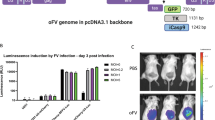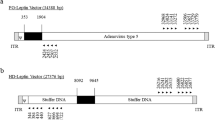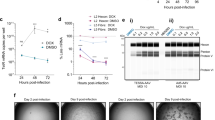Abstract
The genome of the prototype foamy virus (PFV) has been introduced into an adenoviral/PFV hybrid vector and tested for stable in vitro gene transfer. Three different adenoviruses are used to encode: (i) the PFV structural genes gag and pol (Ad-GagPolΔPacI); (ii) the PFV structural gene env (Ad-Env); and (iii) the PFV vector genome (Ad-MD9) encoding the transgene (the enhanced green fluorescent protein (eGFP) gene). Following cotransduction by the three adenoviruses, the target cells become transient PFV vector-producing cells, resulting in the in situ release of recombinant PFV at a titre of up to 103 vector particles/ml, which can then infect surrounding cells, leading to stable integration of the expression cassette. Stable eGFP expression, observed for up to 60 days (11 passages) in cells transduced with all three adenoviral vectors, was shown by PCR to be the result of PFV integration. In contrast, cells transduced with only the adenovirus encoding the PFV vector genome showed a marked decrease in eGFP expression by passage 2 (16 days post-transduction) and did not contain integrated PFV vector. In short, this paper describes the production of a hybrid vector capable of high in vitro transduction and stable transgene expression using adenovirus and PFV vectors.
This is a preview of subscription content, access via your institution
Access options
Subscribe to this journal
Receive 12 print issues and online access
$259.00 per year
only $21.58 per issue
Buy this article
- Purchase on Springer Link
- Instant access to full article PDF
Prices may be subject to local taxes which are calculated during checkout



Similar content being viewed by others
References
Yoshida Y, Emi N, Hamada H . VSV-G-pseudotyped retroviral packaging through adenovirus-mediated inducible gene expression. Biochem Biophys Res Commun 1997; 232: 379–382.
Feng M et al. Stable in vivo gene transduction via a novel adenoviral/retroviral chimeric vector. Nat Biotechnol 1997; 15: 866–870.
Bilbao G et al. Adenoviral/retroviral vector chimeras: a novel strategy to achieve high-efficiency stable transduction in vivo. FASEB J 1997; 11: 624–634.
Ramsey WJ et al. Adenovirus vectors as transcomplementing templates for the production of replication defective retroviral vectors. Biochem Biophys Res Commun 1998; 246: 912–919.
Lin X . Construction of new retroviral producer cells from adenoviral and retroviral vectors. Gene Therapy 1998; 5: 1251–1258.
Reynolds PN, Feng M, Curiel DT . Chimeric viral vectors – the best of both worlds? Mol Med Today 1999; 5: 25–31.
Duisit G, Salvetti A, Moullier P, Cosset FL . Functional characterization of adenoviral/retroviral chimeric vectors and their use for efficient screening of retroviral producer cell lines. Hum Gene Ther 1999; 10: 189–200.
Caplen NJ . Gene therapy: different strategies for different applications. American Society of Gene Therapy: First Annual Meeting, Seattle, Washington, USA, 28–31 May 1998. Mol Med Today 1998; 4: 374–375.
Zheng C, Baum BJ, Iadarola MJ, O'Connell BC . Genomic integration and gene expression by a modified adenoviral vector. Nat Biotechnol 2000; 18: 176–180.
Murphy SJ et al. Novel integrating adenoviral/retroviral hybrid vector for gene therapy. Hum Gene Ther 2002; 13: 745–760.
Chester J et al. Tumor antigen-specific induction of transcriptionally targeted retroviral vectors from chimeric immune receptor-modified T cells. Nat Biotechnol 2002; 20: 256–263.
Bergau et al. Improved retrovirus titres from adeno/retro hybrids by complexing adenovirus components vectors with the polycation DEAE dextran. European Society of Gene Therapy Annual Meeting. Antibes, France, 12th–16th October 2002.
Soifer H et al. A novel, helper-dependent, adenovirus-retrovirus hybrid vector: stable transduction by a two-stage mechanism. Mol Ther 2002; 5 (Part 1): 599–608.
Kubo S, Mitani K . A new hybrid system capable of efficient lentiviral vector production and stable gene transfer mediated by a single helper-dependent adenoviral vector. J Virol 2003; 77: 2964–2971.
Maher BA . Gene therapy trials hit obstacle. Scientist 2002; 16: 26.
Check E . A tragic setback. Nature 2002; 420: 116–118.
Schweizer M et al. Simian foamy virus isolated from an accidentally infected human individual. J Virol 1997; 71: 4821–4824.
Heneine W et al. Identification of a human population infected with simian foamy viruses. Nat Med 1998; 4: 403–407.
Stancek D, Gressnerova M . A viral agent isolated from a patient with subacute thyroditis de Quervain type. Acta Virol 1974; 18: 365.
Cameron KR, Birchall SM, Moses MA . Isolation of foamy virus from patient with dialysis encephalopathy. Lancet 1978; 2: 796.
Lagaye S et al. Human spumaretrovirus-related sequences in the DNA of leukocytes from patients with Graves disease. Proc Natl Acad Sci USA 1992; 89: 10070–10074.
Mahnke C et al. Human spumavirus antibodies in sera from African patients. Arch Virol 1992; 123: 243–253.
Gow JW et al. Search for retrovirus in the chronic fatigue syndrome. J Clin Pathol 1992; 45: 1058–1061.
Wick G et al. Possible role of human foamy virus in Graves' disease. Intervirology 1993; 35: 101–107.
Lycke J et al. Human spumaretrovirus antibody reactivity in multiple sclerosis. J Neurol 1994; 241: 204–209.
Schweizer M, Turek R, Reinhardt M, Neumann-Haefelin D . Absence of foamy virus DNA in Graves' disease. AIDS Res Hum Retroviruses 1994; 10: 601–605.
Heneine W et al. Absence of evidence for human spumaretrovirus sequences in patients with Graves' disease. J Acquir Immune Defic Syndr Hum Retrovirol 1995; 9: 99–101.
Hill CL, Bieniasz PD, McClure MO . Properties of human foamy virus relevant to its development as a vector for gene therapy. J Gen Virol 1999; 80 (Part 8): 2003–2009.
Bieniasz PD, Weiss RA, McClure MO . Cell cycle dependence of foamy retrovirus infection. J Virol 1995; 69: 7295–7299.
Russell DW, Miller AD . Foamy virus vectors. J Virol 1996; 70: 217–222.
Graham FL, Smiley J, Russell WC, Nairn R . Characteristics of a human cell line transformed by DNA from human adenovirus type 5. J Gen Virol 1977; 36: 59–74.
Yang S et al. Generation of retroviral vector for clinical studies using transient transfection. Hum Gene Ther 1999; 10: 123–132.
Riggs JL, McAllister RM, Lennette EH . Immunofluorescent studies of RD-114 virus replication in cell culture. J Gen Virol 1974; 25: 21–29.
Gluzman Y . SV40-transformed simian cells support the replication of early SV40 mutants. Cell 1981; 23: 175–182.
He TC et al. A simplified system for generating recombinant adenoviruses. Proc Natl Acad Sci USA 1998; 95: 2509–2514.
Russell RA et al. The R region found in the human foamy virus long terminal repeat is critical for both Gag and Pol protein expression. J Virol 2001; 75: 6817–6824.
Pietschmann T et al. Foamy virus capsids require the cognate envelope protein for particle export. J Virol 1999; 73: 2613–2621.
Heinkelein M et al. Improved primate foamy virus vectors and packaging constructs. J Virol 2002; 76: 3774–3783.
Vousden KH, Jat PS . Functional similarity between HPV16E7, SV40 large T and adenovirus E1a proteins. Oncogene 1989; 4: 153–158.
Barbosa MS et al. The region of the HPV E7 oncoprotein homologous to adenovirus E1a and Sv40 large T antigen contains separate domains for Rb binding and casein kinase II phosphorylation. EMBO J 1990; 9: 153–160.
Harada S, Yanagi K . Amino acid sequence homology of Epstein–Barr virus nuclear antigen-2 to adenovirus E1A, human papilloma virus-16 E7 and SV40 large T antigen in the functional domains for growth transformation. Oncogene 1991; 6: 461–462.
Lee I, Barton JK . A distinct intron-DNA structure in simian virus 40 T-antigen and adenovirus 2 E1A genes. Biochemistry 1993; 32: 6121–6127.
Mazzarelli JM, Atkins GB, Geisberg JV, Ricciardi RP . The viral oncoproteins Ad5 E1A, HPV16 E7 and SV40 TAg bind a common region of the TBP-associated factor-110. Oncogene 1995; 11: 1859–1864.
Becker TC et al. Use of recombinant adenovirus for metabolic engineering of mammalian cells. Methods Cell Biol 1994; 43: 161–189.
Ali M et al. No evidence of antibody to human foamy virus in widespread human populations. AIDS Res Hum Retroviruses 1996; 12: 1473–1483.
Channon KM et al. Acute host-mediated endothelial injury after adenoviral gene transfer in normal rabbit arteries: impact on transgene expression and endothelial function. Circ Res 1998; 82: 1253–1262.
Harui A, Suzuki S, Kochanek S, Mitani K . Frequency and stability of chromosomal integration of adenovirus vectors. J Virol 1999; 73: 6141–6146.
Achong BG, Mansel PWA, Epstein MA, Clifford P . An unusual virus in cultures from a human nasopharyngeal carcinoma. J Natl Cancer Inst 1971; 46: 299–302.
Achong BG, Mansel PW, Epstein MA . A new human virus in cultures from a nasopharyngeal carcinoma. J Pathol 1971; 103: 18.
Weiss RA . Foamy retroviruses. A virus in search of a disease [news]. Nature 1988; 333: 497–498.
Svenningsson A et al. No evidence for spumavirus or oncovirus infection in relapsing-remitting multiple sclerosis. Ann Neurol 1992; 32: 711–714.
Herchenroder O et al. Isolation, cloning, and sequencing of simian foamy viruses from chimpanzees (SFVcpz): high homology to human foamy virus (HFV). Virology 1994; 201: 187–199.
Herchenroder O et al. Infectious proviral clones of chimpanzee foamy virus (SFVcpz) generated by long PCR reveal close functional relatedness to human foamy virus. Virology 1995; 214: 685–689.
Bieniasz PD et al. A comparative study of higher primate foamy viruses, including a new virus from a gorilla. Virology 1995; 207: 217–228.
Trobridge G, Vassilopoulos G, Josephson N, Russell DW . Gene transfer with foamy virus vectors. Methods Enzymol 2002; 346: 628–648.
Darquet AM et al. A new DNA vehicle for nonviral gene delivery: supercoiled minicircle. Gene Therapy 1997; 4: 1341–1349.
Acknowledgements
This work was supported by The Wellcome Trust, The Jefferiss Research Trust and Cancer Research UK.
Author information
Authors and Affiliations
Rights and permissions
About this article
Cite this article
Russell, R., Vassaux, G., Martin-Duque, P. et al. Transient foamy virus vector production by adenovirus vectors. Gene Ther 11, 310–316 (2004). https://doi.org/10.1038/sj.gt.3302177
Received:
Accepted:
Published:
Issue Date:
DOI: https://doi.org/10.1038/sj.gt.3302177
Keywords
This article is cited by
-
Vergleich verschiedener viraler Vektoren zur Gentherapie von Hornhautendothelzellen
Der Ophthalmologe (2005)



